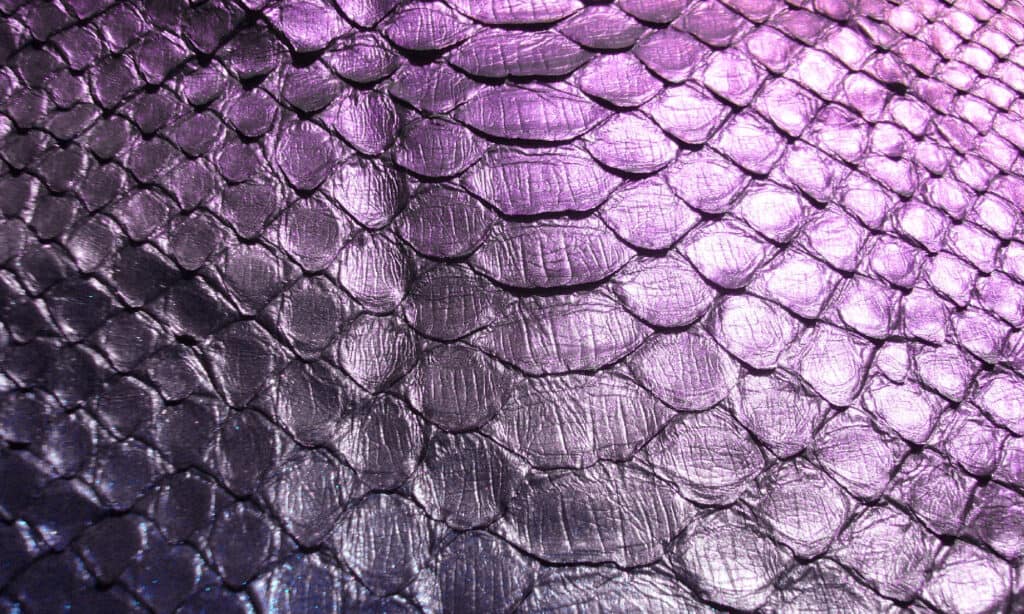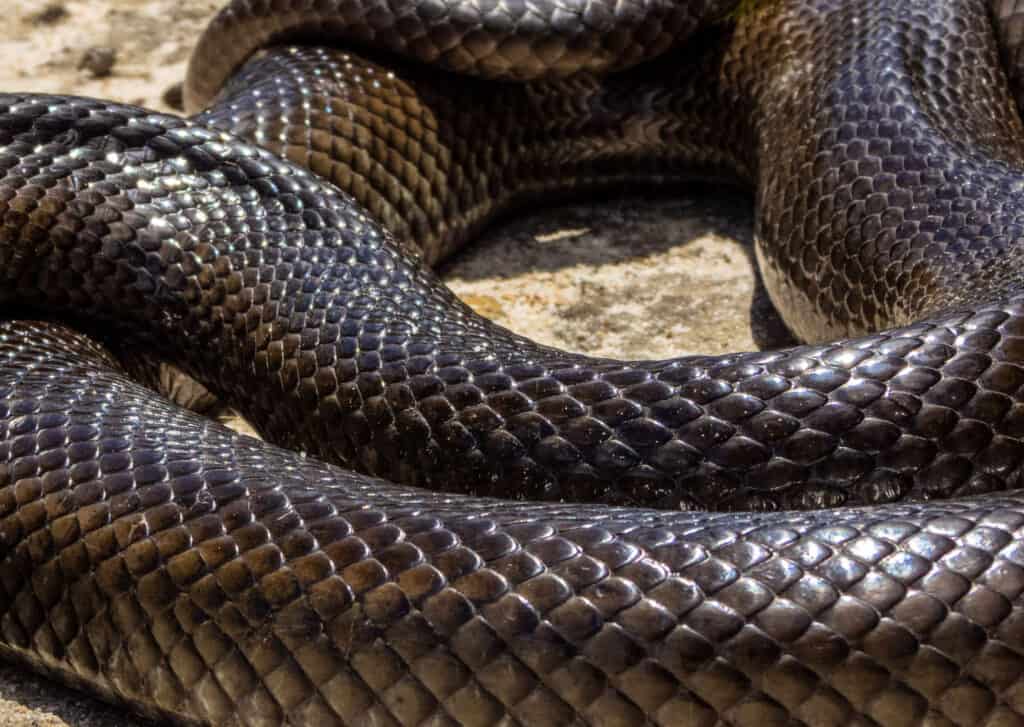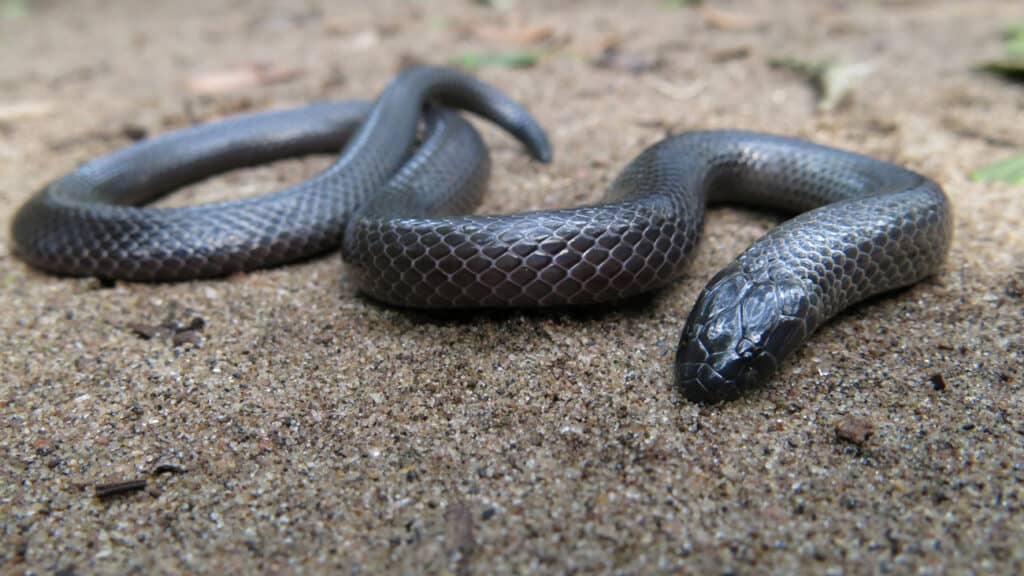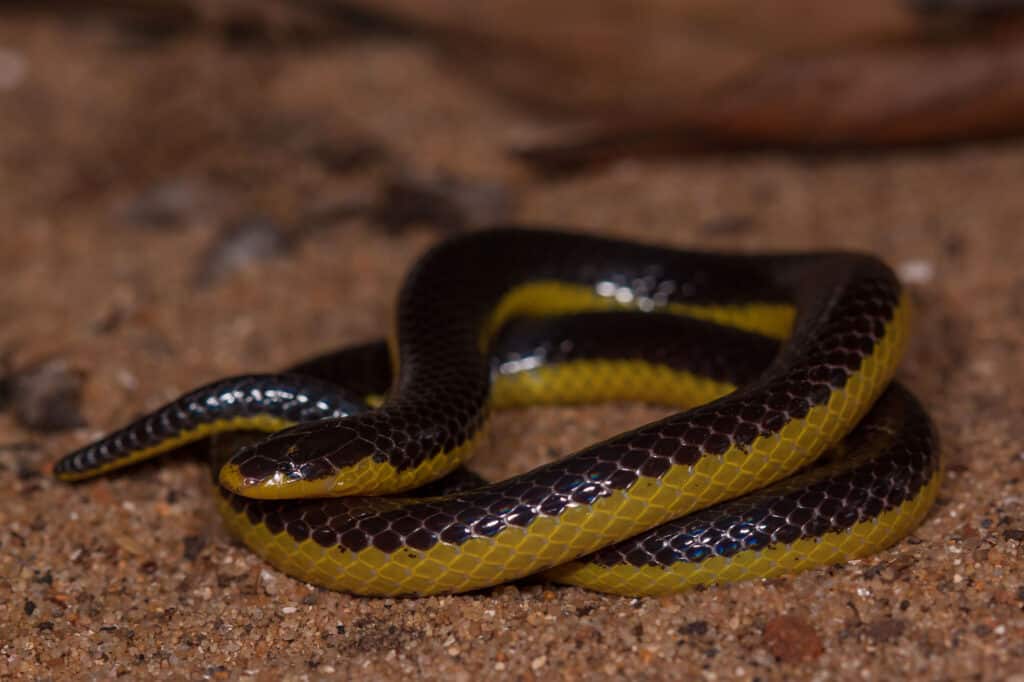Snakes are among the most beautiful animals in the world. Ironically, they are also among the most dangerous, as a dose of venom from some snakes can kill an adult human. These legless reptiles come in various colors, such as black, green, yellow, and sometimes purple and even rainbow.
Purple snakes are quite rare and desired among snake fans and owners for their unique colors. The demand for these unique-colored snakes has prompted breeders to create purple morphs of popular snake species such as the purple passion ball python. However, there are naturally occurring purple snakes. This article reveals 11 purple snakes that you never knew existed.
Why Are Some Snakes Purple?

One of the primary reasons that snakes have a purple hue is to help them camouflage.
©Tetyana Tarusina/Shutterstock.com
Although snakes with purple colors are attractive, their colors aren’t only for the aesthetic value. One of the primary reasons that snakes have this hue is camouflage. The variety of colors results from their chromatophore skin cells responsible for the basic colors such as black, brown, and red.
Color variations such as purple are caused by the interaction of these skin cells and are available in different quantities in snakes.
11 Purples Snake Species That Exist in the World
1. Common File Snake (Limaformosa capensis)

Common file snakes have a maximum length of 5.74 feet.
©Bernard DUPONT/ flickr – License
Common file snakes, known in some parts as witchdoctor snakes which bring good luck, are harmless snakes found in Africa. These snakes look like triangular files and have keeled scales atop their purple-pinkish skins and a light dorsal stripe that stretches from their heads to their tails.
According to reports, these harmless snakes have a maximum length of 5.74 feet. These snakes are more likely to spray musk instead of attacking if handled. However, they prey on venomous snakes such as cobras and black mambas. Common file snakes spend most of their lives underground and come out to hunt at night.
2. Mangrove Pit Viper (Trimeresurus purpureomaculatus)

Mangrove pit vipers have triangular heads and stout bodies with keeled scales.
©Kurit afshen/Shutterstock.com
Mangrove pit vipers, otherwise known as shore pit vipers, are venomous snakes commonly found in Bangladesh, India, and parts of Southeast Asia. According to Khaosok National Park, males grow to an average length of 24 inches, and females, which are longer, can reach 35 inches.
Mangrove pit vipers have triangular heads and stout bodies with keeled scales. These vipers have colors that range from olive to purplish brown and are found in humid areas such as mangroves and coastal forests. Despite the unique color variation of these snakes, it is advised to watch them from a distance as they are known to be ill-tempered and will strike fast if they feel threatened.
3. Natal Purple-Glossed Snake (Amblyodipsas concolor)

Natal purple-glossed snakes have dark brown or purple-black skin with a purple gloss
©iStock.com/Willem Van Zyl
The Natal purple-glossed snake is a venomous snake of the Atractaspididae family, which used to be a sub-category of colubrid snakes. Also called the KwaZulu-Natal purple-glossed snake, this rear-fanged species is endemic to southern parts of Africa.
It has a distinct dark brown or purple-black skin with a purple gloss, hence its name. The Natal purple-glossed snake measures 27.5 inches from head to tail tip.
4. Western Purple-Glossed Snake (Amblyodipsas unicolor)

Adult western purple-glossed snakes usually measure around 15.34 inches long.
©iStock.com/Gerrit Rautenbach
The western purple-glossed snake is a rear-fanged snake of the Atractaspididae family. It is found in various parts of the African continent and is one of the most popular purple snakes. Like other snakes in its family, the western purple-glossed snake is venomous. However, its venom is only affects its prey and harmless to humans. Adult western purple-glossed snakes usually measure around 15.34 inches long.
5. Common Purple-Glossed Snake (Amblyodipsas polylepis)

Common purple snakes have more rows of dorsal scales than any other Amblyodipsas species.
©Ryanvanhuyssteen / CC BY-SA 4.0 – License
The common purple gloss snake has a blackish-brown color with a purple gloss finish. These snakes measure up to 30 inches long and are venomous. They are found in many parts of Africa, including Namibia, Zambia, and Botswana. Common purple snakes have more rows of dorsal scales than any other Amblyodipsas species. They are also venomous, but their venom is only lethal to their prey.
6. Eastern Purple-Glossed Snake (Amblyodipsas microphthalma)

The eastern purple gloss grows just under 12 inches long and has 15 rows of dorsal scales.
©iStock.com/Dylan Leonard
Like other Amblyodipsas species, the eastern purple gloss snake is rear-fanged and venomous. It is brown and white, with the purple gloss typical of its species. The eastern purple gloss grows just under 12 inches long and has 15 rows of dorsal scales. The species can be found in parts of South Africa and Mozambique.
7. Katanga Purple-Glossed Snake (Amblyodipsas katangensis)
The Katanga purple-glossed snake is a rear-fanged snake of the Lamprophiidae family and is found in many parts of Africa. There are two subspecies of the Katanga purple-glossed snake, which are venomous and have brown or black skin with a purple gloss. Katanga purple-gloss snakes are nocturnal and hunt down mammals, reptiles, and birds, like other snakes in its family.
8. Rodhain’s Purple-Glossed Snake (Amblyodipsas rodhaini)
The Rodhain’s purple-glossed snake was named in honor of Jérome Alphonse Hubert Rodhain, a physician and zoologist. The species is of the Atractaspididae family and is rear-fanged and venomous. In addition to this, Rodhain’s purple-glossed snake is known to be secretive and nocturnal. Although its venom has not been properly studied, we know it is effective on the small mammals, reptiles, and birds it preys on.
9. Mpwapwa Purple-Glossed Snake (Amblyodipsas dimidiata)
The Mpwapwa purple-glossed snake is black and white with a purple gloss. It can be identified by its upper white lip and 17 rows of dorsal scales. Adult Mpwapwa purple-glossed snakes are often as long as 19 inches. These rear-fanged snakes are venomous and are found in various parts of The Republic of Congo.
10. Kalahari Purple-Glossed Snake (Amblyodipsas ventrimaculata)
The Kalahari purple-glossed snake is found in various parts of Zimbabwe, Zambia, Namibia, and Botswana. It is rear-fanged and venomous like other species under the Amblyodipsas genus, but little else is known about the species. A study referred to it as a “poorly known and overlooked” African snake species.
11. Teitana Purple-Glossed Snake (Amblyodipsas teitana)
Teitana purple-glossed snake is a rear-fanged species of the Atractaspididae family. The species was first studied by Arthur Loveridge in 1936, but little else has been done since then. On average, Teitana purple-glossed snakes measure 16.9 inches long and are only found in the Taita Hills in Kenya.
| Species | Venomous? | |
|---|---|---|
| 1. | Common File Snake | No |
| 2. | Mangrove Pit Viper | Yes–toxic to humans |
| 3. | Natal Purple-Glossed Snake | Yes–mild; not dangerous to humans |
| 4. | Western Purple-Glossed Snake | Yes–mild; not dangerous to humans |
| 5. | Common Purple-Glossed Snake | Yes–mild; not dangerous to humans |
| 6. | Eastern Purple-Glossed Snake | Yes–mild; not dangerous to humans |
| 7. | Katanga Purple-Glossed Snake | Yes–mild; not dangerous to humans |
| 8. | Rodhain’s Purple-Glossed Snake | Yes–mild; not dangerous to humans |
| 9. | Mpwapwa Purple-Glossed Snake | Yes–mild; not dangerous to humans |
| 10. | Kalahari Purple-Glossed Snake | Yes–mild; not dangerous to humans |
| 11. | Teitana Purple-Glossed Snake | Yes–mild; not dangerous to humans |
Can Mangrove Pit Viper Venom Help Cure Cancer?
There’s no denying that a bite from a venomous mangrove pit viper is dangerous to a human, as its cytotoxic venom can cause severe pain, swelling, systemic bleeding, necrosis of the flesh, and sometimes death. However, these snakes could be beneficial for humans suffering from cancer. A particular study of the cytotoxic effect of the venom in this snake was conducted among those suffering from prostate, colon, lung, and breast cancer. Results found that the tissue-necrotizing effect resulting from cytotoxic venom could be an agent utilized in drugs to fight those types of cancers. Studies continue, with pit viper species sitting on the radar of researchers intent on finding cures for this deadly disease in humans.
The photo featured at the top of this post is © Kurit afshen/Shutterstock.com
Discover the "Monster" Snake 5X Bigger than an Anaconda
Every day A-Z Animals sends out some of the most incredible facts in the world from our free newsletter. Want to discover the 10 most beautiful snakes in the world, a "snake island" where you're never more than 3 feet from danger, or a "monster" snake 5X larger than an anaconda? Then sign up right now and you'll start receiving our daily newsletter absolutely free.
Sources
- National Parks, Available here: https://www.nparks.gov.sg/florafaunaweb/fauna/4/8/487
- Khaosok, Available here: https://www.khaosok.com/national-park/mangrove-pit-viper/
- AfricanSnakeBiteInstitute, Available here: https://www.africansnakebiteinstitute.com/snake/common-file-snake/
Thank you for reading! Have some feedback for us? Contact the AZ Animals editorial team.






